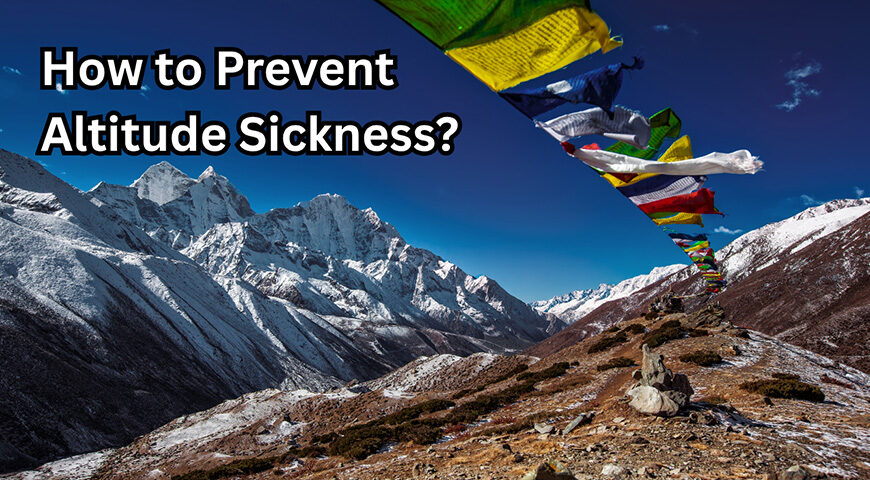How to Prevent Altitude Sickness?
Authored by: Dr. Leonard Leng (MBBS, MMed FM, GDOM)
Last updated: Oct 07, 2025
Key Takeaways:
|
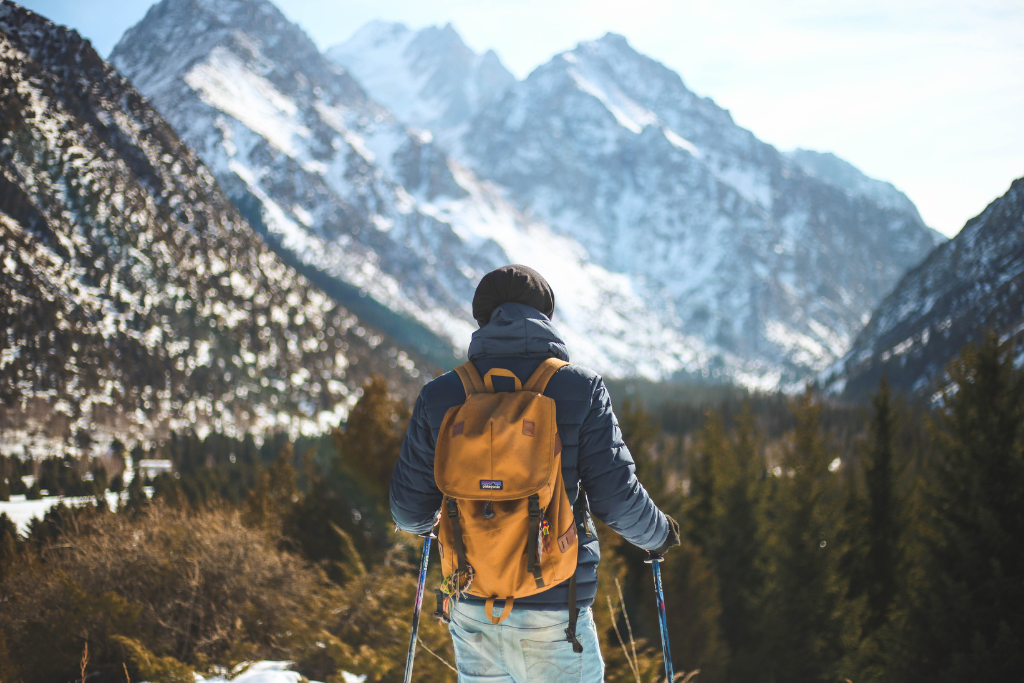
Hiker with backpack trekking through snow-covered mountains showing risk of altitude sickness
Altitude sickness can sneak up on anyone heading to higher elevations, whether you are an experienced hiker or travelling for the first time. The good news is that with some preparation, healthy habits and, if needed, altitude sickness medication, you can help your body adjust naturally and enjoy your mountain adventure without feeling unwell along the way.
Popular trekking destinations such as the Annapurna and Everest regions attract the vast majority of Nepal’s high-altitude visitors, together receiving nearly 240,000 trekkers in 2019, accounting for 95% of trekking destinations in Nepal. These routes draw thousands each year to mountain trails and base camps and beyond where oxygen levels drop significantly.
In this article, we explore what causes altitude sickness, how to recognise the signs, and practical ways to prevent it.
What Is Altitude Sickness?
Altitude sickness, also known as acute mountain sickness (AMS), occurs when the body doesn’t acclimatise quickly enough to the lower oxygen levels found at higher elevations. As you ascend, air pressure drops and there is less oxygen available for your body to use. In response, your breathing and heart rate increase to maintain oxygen supply.
It typically develops within a few hours when you climb above about 8,000 feet (around 2,440 metres), where the air becomes noticeably thinner, such as during hikes to Mount Kinabalu in Malaysia or Ghorepani Poon Hill in Nepal.
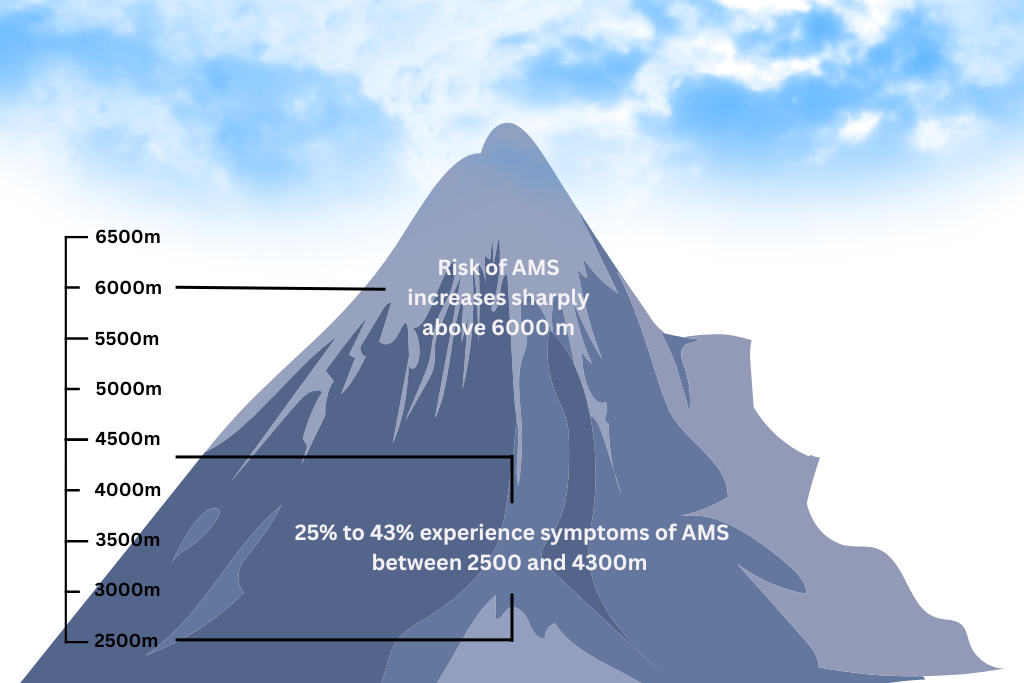
Infographic of mountain showing percentage of people experiencing altitude sickness by elevation
Studies show that 25% to 43% of people ascending to altitudes between 2,500 and 4,300 metres experience symptoms of acute mountain sickness (AMS). The risk increases sharply above 6,000 metres, affecting more than 60% of climbers who ascend rapidly without proper acclimatisation.
Common symptoms include headache, nausea, dizziness, fatigue, and difficulty sleeping. In more severe cases, altitude sickness can progress to high-altitude pulmonary oedema (HAPE) or high-altitude cerebral oedema (HACE), both of which require immediate medical attention.
What Contributes to Altitude Sickness?
Several factors can make you more prone to developing altitude sickness, especially if your body does not have enough time to acclimatise properly. These include:
- Rapid ascent or gaining altitude too quickly – climbing too fast doesn’t give your body time to adjust to the thinner air, which is the most common cause of altitude sickness.
- Physical exertion soon after arrival – strenuous activity increases your body’s oxygen demand before it has fully adapted to the lower oxygen levels.
- A previous history of altitude sickness – if you’ve had it before, your body may be more sensitive to altitude changes on future trips.
- Dehydration – inadequate hydration can affect blood flow and oxygen delivery, worsening fatigue and headaches.
- Alcohol or sedative use – these substances slow breathing and reduce oxygen intake, interfering with your body’s natural acclimatisation process.
Everyone adapts differently, so even experienced trekkers may develop symptoms if they ascend too quickly or overexert themselves before their body has adjusted.
Tips to Prevent Altitude Sickness
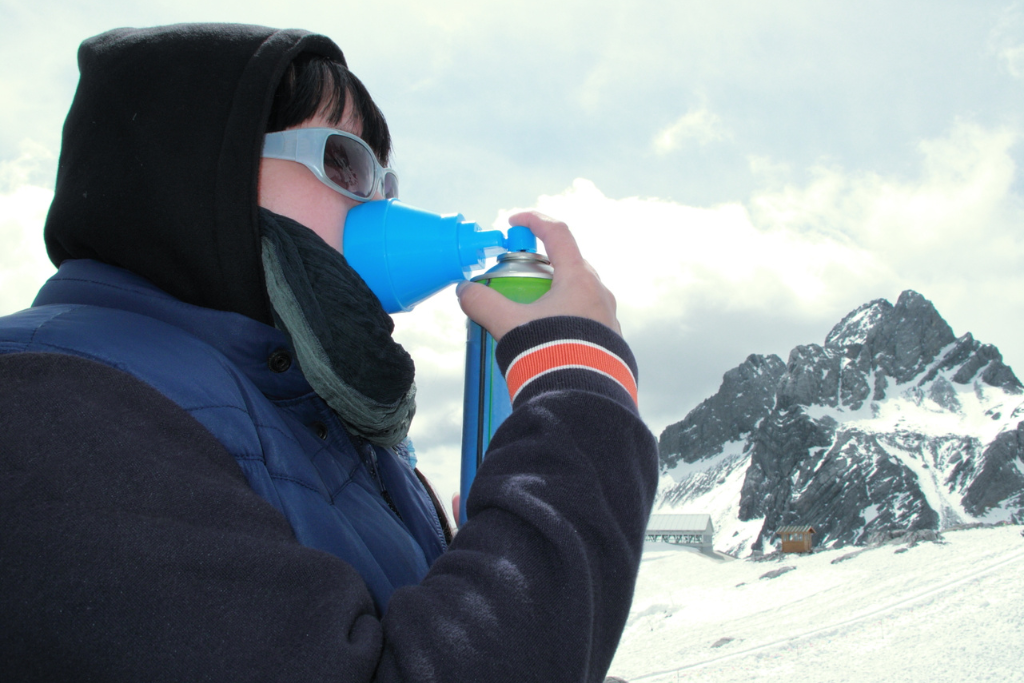
Traveller using portable oxygen canister for relief of altitude sickness in cold mountain area
1. Ascend Gradually
The most important way to prevent altitude sickness is to give your body time to acclimatise.
- Avoid flying directly to high-altitude areas if you can. A gradual approach helps your body adjust to changes in oxygen levels.
- Spend 2 to 3 days getting used to higher elevations before going above 3,000 metres.
- Try not to climb more than 300 to 500 metres a day.
- For every 600 to 900 metres you gain, or every 3 to 4 days of climbing, include a rest or acclimatisation day before continuing higher.
2. Avoid Overexertion
It’s easy to get excited and push yourself at the start of a climb, but doing too much too soon can increase your risk of altitude sickness. Move at a steady and comfortable pace, and take regular breaks to let your body adjust. Rest well each night to recover before continuing your ascent.
3. Stay Hydrated
Dehydration can make altitude sickness symptoms worse because it reduces blood circulation and the body’s ability to deliver oxygen efficiently. Drink plenty of fluids throughout the day to stay well hydrated. Water, electrolyte drinks and warm soups are good options.
Avoid too much caffeine or alcohol, as they can cause fluid loss and make it harder for your body to adjust and rest properly.
4. Sleep Lower, Climb Higher
When trekking or climbing, follow the “climb high, sleep low” principle. This means ascending to a higher altitude during the day but returning to a lower level to sleep.
Sleeping at a slightly lower altitude gives your body time to recover from the reduced oxygen levels experienced during the climb. It also helps your body adapt more gradually, reducing the risk of developing symptoms of altitude sickness.
5. Eat Light and Balanced Meals
Your body needs a steady supply of energy to adapt to higher altitudes, but digestion can slow down when oxygen levels drop. Eating light and balanced meals helps prevent nausea, bloating and fatigue, which are more common at altitude.
Choose easily digestible foods such as carbohydrates, fruits and vegetables, which provide energy without putting extra strain on your stomach. Avoid heavy, oily or spicy meals during your ascent, as they can make you feel sluggish or uncomfortable.
6. Keep Warm
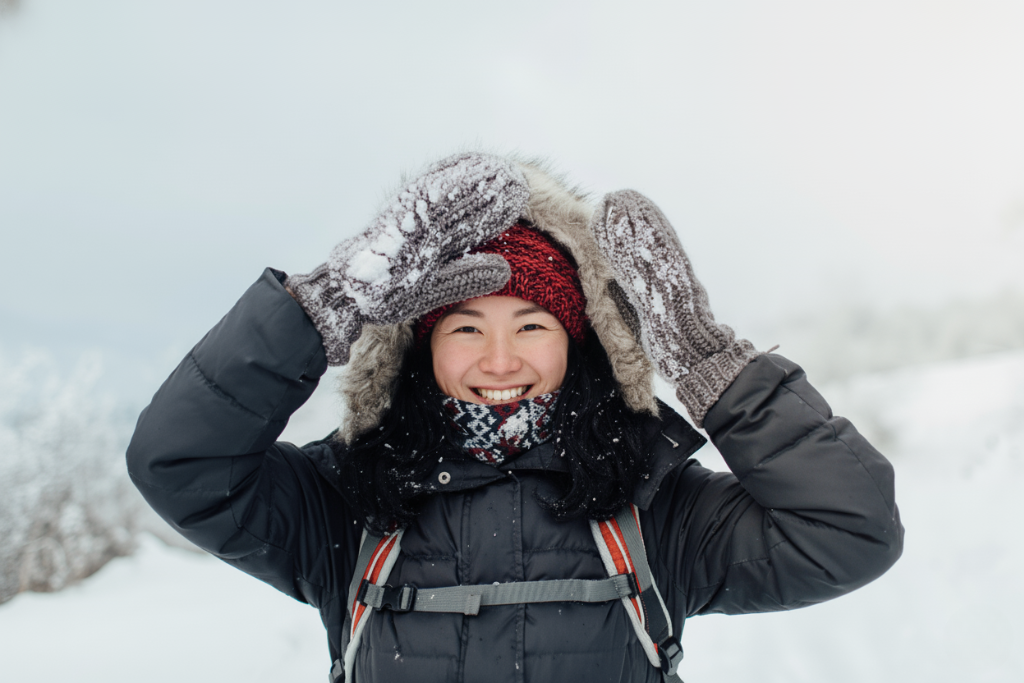
Smiling woman dressed in winter jacket and gloves staying warm to prevent altitude sickness
Cold weather at high altitudes adds extra strain on your body and can make it harder to acclimatise. When your body gets too cold, it uses more energy to stay warm instead of adjusting to the thinner air.
Dress in layers so you can stay comfortable as temperatures change. For example, wear a light inner layer to absorb sweat, a warm middle layer for insulation, and an outer jacket to protect against wind and rain. Keep your hands, feet and head covered, and make sure your clothes stay dry.
7. Avoid Alcohol and Smoking
Both alcohol and smoking make it harder for your body to get enough oxygen at high altitude. Alcohol causes dehydration and can slow your breathing, which reduces the amount of oxygen in your blood. Smoking affects lung function and limits how well oxygen is absorbed. These effects can worsen symptoms such as headache, fatigue and breathlessness.
Avoiding both during your trip helps your body acclimatise more effectively and reduces the risk of altitude sickness.
8. Consider Preventive Medication
Certain prescription medications can help reduce the risk of altitude sickness, especially if you have experienced it before or need to ascend quickly. These medicines support your body’s ability to adjust to lower oxygen levels and are prescribed based on individual needs.
Common options include:
| Medication | How It Works and When It’s Used | Side Effects and Usage Notes |
| Acetazolamide (Diamox) |
|
|
| Dexamethasone |
|
|
If you require these medications, it is advisable to consult your doctor in advance to determine the appropriate dosage and timing for your trip.
What to Do If You Develop Symptoms?
If you start to feel unwell at altitude, do not ignore it. Mild symptoms such as headache, nausea or light-headedness are signs that your body is struggling to adjust. Stop climbing higher and focus on rest and hydration. Most mild cases improve within a day with proper rest.
If your symptoms do not improve after 24 hours, or if they become worse, take the following steps:
- Descend to a lower altitude as soon as possible.
- Seek medical help if severe symptoms develop, such as confusion, difficulty breathing at rest or coughing up pink, frothy sputum, which may indicate high-altitude pulmonary oedema (HAPE).
Oxygen therapy and portable hyperbaric chambers may be available at some trekking stations. These can provide temporary relief while medical help or evacuation is being arranged.
Preparing Before Your Trip
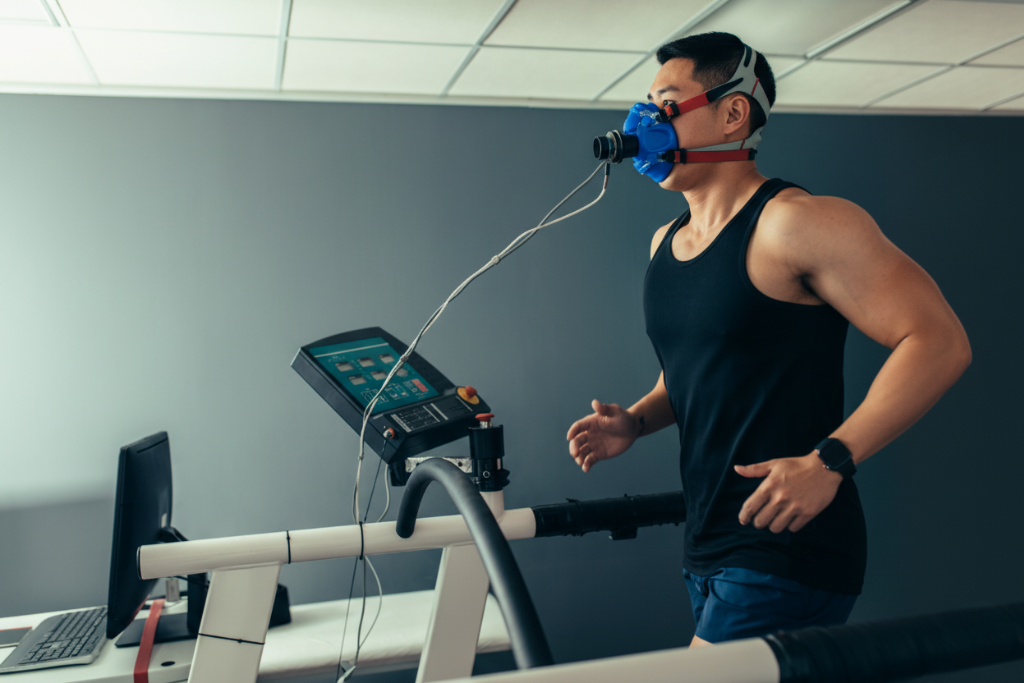
Man training on treadmill with breathing mask simulating high altitude to prevent altitude sickness
A little preparation before your high-altitude trip can make a big difference in how comfortably you adjust.
- Train adequately for your trip depending on how high you plan to climb or travel. Good general fitness helps your body use oxygen more efficiently and reduces fatigue at altitude.
- Schedule a pre-travel medical check-up with your doctor to discuss your itinerary, any existing health conditions and personal risk factors.
- Pack essential items such as water purification tablets, prescribed medication and a basic first-aid kit so you are prepared for unexpected situations.
Travelling at high altitude can be an amazing experience. With the right preparation, pacing and awareness, most people can adapt safely and enjoy their journey without major discomfort.
Post Credit: atamed.sg
Contact: https://atamed.sg/contact-us

